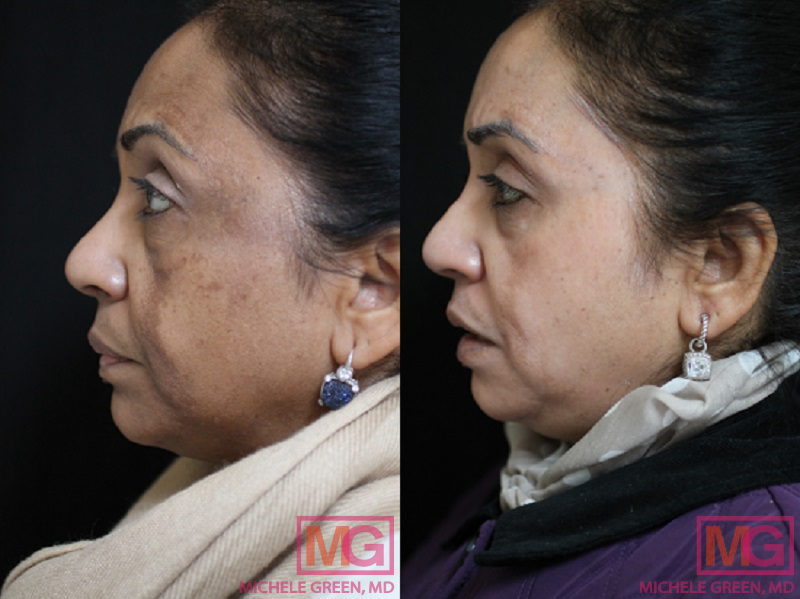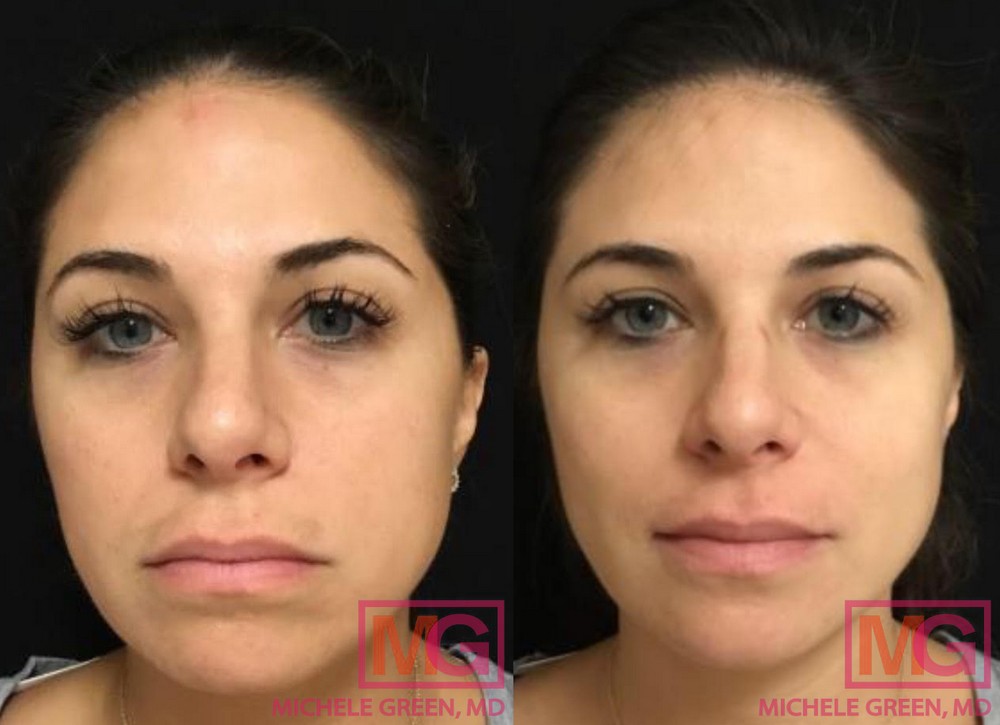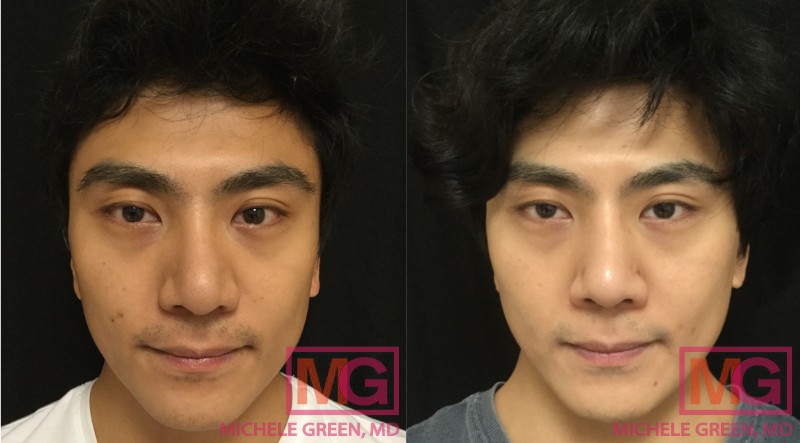Which Chemical Peel is Right For Me?
Over time, signs of aging become etched onto the skin’s surface as collagen production decreases, including dark spots from sun damage, fine lines, wrinkles, and acne scars, which result in uneven skin tone and skin texture on the face. Other skin concerns may continue to persist, such as large pores, active acne breakouts, and melasma, leading patients to seek out a treatment option that will provide smoother, clearer skin. Fortunately, at the New York City office of expert board-certified dermatologist Dr. Michele Green, there is a wide array of treatment options available, including laser resurfacing treatments, microneedling, microdermabrasion, dermal fillers, and more. To address blemishes, fine lines, hyperpigmentation, acne breakouts, acne scars, and general uneven skin texture, Dr. Green will frequently turn to chemical peels. But with so many options, how do you know which chemical peel is right for you?
Chemical peels are acid solutions applied to the skin’s surface. They react with the debris and dead skin cells on the outer and inner layers of skin to exfoliate the outer layer and promote new skin cell turnover. Chemical peels are formulated with various types of acids in different concentrations, meaning they can penetrate a range of depths to address many skin concerns. At Dr. Green’s dermatology office, she chooses the type of exfoliating peel that is right for your skin type, with options for patients with darker skin tones, dry skin, acne-prone skin, and sensitive skin, which will address skin concerns without serious side effects or discomfort. From superficial peels, such as glycolic acid peels, salicylic acid peels, or lactic acid peels, to medium-depth peels, such as TCA peels, to deep peels, such as phenol peels, Dr. Green’s office provides excellent treatment to brighten and smooth out the skin. The best first step in determining which chemical peel is right for you is to schedule your initial consultation with Dr. Green.
Dr. Green is an internationally renowned board-certified cosmetic dermatologist with over 25 years of experience providing some of the most discerning men and women worldwide with the best non-invasive cosmetic treatment options, including chemical peels. For her dedication to her patients and expertise, she is consistently voted as one of the best dermatologists in NYC by Castle Connolly, the New York Times, Super Doctors, and New York Magazine. When you consult with Dr. Green for your facial rejuvenation treatment, she will work with you to create a customized approach that includes a unique combination of in-office cosmetic procedures and specially formulated skincare products best suited to your specific needs and goals.
What is a chemical peel?
A chemical peel is a treatment that uses a chemical solution — also known as a chemical exfoliant — to remove the outermost layer of skin. When dead skin cells, oil, dirt, and other debris are removed from the skin’s surface, the exfoliation helps to promote new skin cell growth and skin cell turnover for clearer, smoother, brighter skin. One of the most commonly performed cosmetic procedures, chemical peels can be used to address many skin concerns, including:
- Hyperpigmentation
- Clogged pores
- Dullness
- Active acne breakouts
- Acne scars
- Fine lines
- Wrinkles
- Sun damage
- Large pores
- Uneven skin tone
- Uneven skin texture
Different types of chemical peels address these concerns. During your initial consultation with Dr. Green, she will examine the treatment area to determine which peel is right for you.
What are the different types of chemical peels?
Many different types of chemical peels are available at Dr. Green’s office, ranging in depth of penetration and the active ingredient of the chemical solution. Each chemical peel falls into one of three overarching categories, broadly used to define the depth of penetration: superficial peels (light chemical peels), medium-depth peels, and deep chemical peels. Superficial peels are used to remove only the outermost layer of skin to treat fine lines, acne breakouts, dry skin, and uneven skin tone. Often, superficial peels are repeated every two weeks for several months as a part of your skincare routine to achieve optimal results. Since these peels are light, there is very little downtime or discomfort associated with the treatment process. The two main types of chemical peels that fall under the umbrella of superficial peels include alpha hydroxy acid peels, such as glycolic acid peels, lactic acid peels, tartaric acid peels, and citric acid peels, and beta hydroxy acid peels, such as salicylic acid peels.
Medium-depth peels use a more concentrated peeling solution that penetrates deeper into the inner layers of the skin. They are primarily used to treat areas of hyperpigmentation, sun damage from unprotected sun exposure, melasma, acne scars, and deeper lines and wrinkles. One of the most frequently used medium-depth peels is a trichloroacetic acid (TCA) peel, which can be used in combination with salicylic acid peels to address various skin concerns. It is common for medium-depth peels to cause side effects, including redness and irritation, which necessitates more downtime than a superficial peel.
The last overarching type of chemical peel is a deep chemical peel, which penetrates deep into the inner layers of skin to address deep lines and wrinkles, severe scarring, extensive sun damage, and pre-cancerous growths. Deep chemical peels are a significant procedure that necessitates the use of a numbing solution to reduce discomfort during the process. While deep chemical peels provide patients with dramatic results, there is significant downtime associated with deep chemical peels and a higher risk of side effects. Patients with darker skin tones should avoid deep chemical peels, as they can result in scarring and post-inflammatory hyperpigmentation.

What is a glycolic acid peel?
A glycolic acid peel is a type of alpha hydroxy acid peel, which is considered the most gentle type of chemical peel. Alpha hydroxy acid peels are a categorization of chemical peels that include mandelic acid peels, glycolic acid peels, tartaric acid peels, malic acid peels, and lactic acid peels. Glycolic acid peels, specifically, are chemical solutions created with glycolic acid as the active ingredient, which is derived from sugar cane. The small molecular structure of the sugar cane allows the glycolic acid peel to penetrate the inner layers of the skin. Glycolic acid peels are best used for reducing the appearance of fine lines, minor acne, mild pigmentation, and uneven skin tone and texture. The peel can help to hydrate and rejuvenate the skin with multiple treatment sessions.
What are BHA peels?
BHA peels, which are also known as beta hydroxy acid peels, are classified as lipid-based peels. Typically, BHA peels are superficial peels that work best for addressing acne breakouts, blemishes, and clogged pores. The most common type of BHA peel is the salicylic acid peel, which Dr. Green will often turn to to reduce acne breakouts, clear the pores, and reduce excess oil on the skin. Salicylic acid acts as an anti-inflammatory treatment, which can also help in reducing the impact of active acne breakouts.
What are TCA peels?
TCA peels contain the active ingredient of trichloroacetic acid (TCA). They can be used in various strengths and in combination with other ingredients to address a wide range of cosmetic and medical concerns. Typically, TCA peels are considered medium-depth peels. If the concentration of the acidic solution exceeds 20%, the chemical peel should be performed by a board-certified dermatologist, such as Dr. Green, rather than an esthetician. Depending on the concentration of the chemical solution, TCA peels can be used to address hyperpigmentation, sun damage, deep wrinkles, acne scars, and actinic keratosis (pre-cancerous growths).
Do at-home chemical peels work?
Some types of mild or light chemical peels can be performed at home as a part of your weekly skincare routine. These light peels can help to address mild acne breakouts, slight discoloration on the skin’s surface, and fine lines. It is essential to avoid over-peeling your skin. As such, a light chemical peel should be performed at home at most once a week. Patients should never attempt a medium-depth or deep chemical peel at home, as this can lead to serious side effects, including scarring and hyperpigmentation. For the best results, it is always best to consult with an expert dermatologist, such as Dr. Green, who can recommend the type of chemical peel that will best meet your needs.
What is the best chemical peel for skin resurfacing?
Chemical peels are a safe and effective skin resurfacing treatment option, providing patients with smoother, clearer, brighter skin. The treatment works by applying a chemical solution to the outer layer of the skin, which reacts with the chemical bonds in the skin cells to break down. Once broken, the skin cells slough off, allowing new skin cells to form and eliminating areas of pigmentation, uneven skin texture, acne scars, and fine lines. The amount of time it takes to see the resurfacing results of the treatment depends on the depth and concentration of the peel. When you have your initial consultation with Dr. Green, she will examine the treatment area and discuss your aesthetic goals to recommend the best chemical peel for skin resurfacing.

Which chemical peel removes dark spots?
Patients sometimes ask, “Which chemical peel is best for skin whitening?” Many types of chemical peels help remove dark spots, but typically, Dr. Green will turn to the Cosmelan or Vi peel. The Cosmelan peel is a two-part chemical peel applied in Dr. Green’s office. Depending on your skin type and the extent of the hyperpigmentation, Dr. Green will let you know how long to keep the peel on your skin. Once the Cosmelan peel has been removed, patients should always wear sunscreen of SPF 30 or higher when going outside to avoid unwanted side effects. The Vi peel uses a chemical solution comprised of salicylic acid, vitamin C, trichloroacetic acid, and retinol, which has powerful antioxidant properties to lighten the skin. The Vi peel is highly effective for dark spots from sun damage, acne scars, and other forms of pigmentation.
Which chemical peel is best for hyperpigmentation?
Patients often ask, “Which peel is good for pigmentation?” Especially when it comes to treating hyperpigmentation conditions, such as melasma, it is essential to choose a treatment option that is safe and effective. Melasma is notoriously difficult to treat, and patients who attempt laser treatment for melasma may experience a worsening of the condition. Chemical peels, such as the Cosmelan peel, are a treatment option for melasma. Dr. Green will most often turn to the Cosmelan peel for treating melasma, as the chemical solution contains azelaic acid, phytic acid, ionic acid, and ascorbic acid, which work together to inhibit the production of melanin in the melanocytes. In addition, Mesopeels with depigmentation creams can improve both skin tone and hyperpigmentation.
Which peel is best for wrinkles?
Dr. Green offers several types of chemical peels that are highly effective in reducing the appearance of fine lines and wrinkles that vary in depth based on the severity of the wrinkles:
- Glycolic acid peels are one of the gentlest types of chemical peels that can work well for fine lines. They help initiate the production of new collagen to reduce the appearance of mild creases.
- Jessner Peels contain several chemicals, including lactic acid, salicylic acid, and resorcinol, which work to hydrate and lighten the skin. The treatment effectively reduces the appearance of fine lines, wrinkles, melasma, and other types of hyperpigmentation.
- Retinol chemical peels are derived from vitamin A and work to trigger skin cell turnover and new skin growth. The treatment helps to hydrate and brighten the skin and reduces the appearance of fine lines and wrinkles.
Which Chemical Peel is best for stretch marks?
Stretch marks are a type of scar that forms when the skin stretches or retracts quickly. Characterized by long depressions in the skin, stretch marks typically appear red, pink, or purple when they form initially, then gradually turn white or silver over time. Chemical peels can be one treatment option for reducing the appearance of stretch marks by resurfacing the scarred area. Typically, Dr. Green will turn to a TCA peel or glycolic acid peel to reduce the appearance of stretch marks. Other treatment options include the Fraxel laser, Sculptra injections, and the VBeam laser.
Which is better: Chemical Peel or Microdermabrasion?
Microdermabrasion is a treatment in which the outer layer of skin is exfoliated using aluminum oxide crystals. Similarly to chemical peels, microdermabrasion helps to remove dead skin cells to trigger skin cell turnover for smoother, clearer, brighter skin. To determine which treatment option will work best for you, schedule your consultation appointment with expert board-certified dermatologist Dr. Michele Green.

Which is better: Chemical Peel or Microneedling?
Microneedling is a safe and effective treatment for reducing the appearance of fine lines, wrinkles, sun damage, stretch marks, hyperpigmentation, and large pores to create a smoother, clearer look for the skin. The treatment process involves the application of a dermal roller, which has many medical-grade needles that pierce the skin’s surface, creating controlled injuries to the skin. These micro-injuries boost the body’s natural healing response, which increases collagen production. Often, Dr. Green will pair microneedling with PRP treatment to improve the results. Chemical peels and microneedling address similar concerns but should not be paired together. Neither is inherently better than the other, but patients should avoid microneedling if they are experiencing active acne breakouts, which is not the case for chemical peels, which can often be used to address acne.
Which is better: Chemical Peel or laser resurfacing?
Patients often wonder, “Which is better: chemical peel or laser?” Both chemical peels and laser resurfacing treatments can help address uneven skin texture, uneven skin tone, hyperpigmentation, fine lines, wrinkles, and scarring. Both treatments increase skin cell turnover to rejuvenate the treatment area, providing smoother, clearer, brighter skin. Neither treatment is inherently better than the other. Rather, they differ mostly in their method of action. Dr. Green will help you determine which is best for you based on your aesthetic goals.
Which moisturizer is best after a chemical peel?
Following your chemical peel treatment, Dr. Green will provide you with aftercare instructions, including the best type of moisturizer to use. Typically, Dr. Green recommends a heavy moisturizer, as the skin will often dry out following a chemical peel. It is also crucial that patients practice strict sun avoidance by applying sunscreen of SPF 30 or higher before going outside, reapplying every two hours that are spent outside, and ideally avoiding direct sunlight when the sun is at its most intense (between 10 am and 2 pm).
Which Chemical Peel is the best?
With many types of chemical peels to choose from, it can be difficult to know which peel is best for you. The different types of peels range in depth and concentration to address many skin concerns, including hyperpigmentation, melasma, sun damage, acne breakouts, acne scars, fine lines, wrinkles, large pores, and pre-cancerous growths. The first step in determining which peel is best for you is to schedule a consultation with expert board-certified dermatologist Dr. Michele Green. During your initial consultation, Dr. Green will examine the treatment area and discuss your aesthetic goals to determine which chemical peel is best for you.

How do I get started with chemical peel treatment today?
Suppose you are looking for a way to revitalize your skin and rejuvenate your appearance. In that case, a chemical peel is an excellent non-invasive treatment option that will provide you with the cosmetic results you’re after. Chemical peels are a completely customizable treatment option that can target and resolve many skin conditions, including acne scars, age spots, discoloration, fine lines and wrinkles, melasma, and even rosacea. Chemical peels are designed to exfoliate the skin and eliminate dead skin cells from the top layer, allowing for healthier, brighter, more youthful-looking skin. Dr. Green often incorporates chemical peels into her patients’ treatment plans as they are a quick, painless way to achieve an overall improved complexion without any downtime whatsoever.
Dr. Michele Green is a board-certified dermatologist with over 25 years of experience. She treats her patients with non-invasive cosmetic procedures such as lip fillers, Botox, body contouring, various laser treatments, and chemical peels. Dr. Green has consistently been voted as a top NYC dermatologist by Castle Connolly, New York Magazine, Super Doctors, and The New York Times due to her amazing work and dedication to her patients. Dr. Green will work with you to generate a customized plan to rejuvenate your skin using a combination of in-office cosmetic treatments and specially formulated skincare products for at-home use that are best tailored to your specific skin goals. Please call us at 212-535-3088 or email our New York City-based office today to schedule a consultation with Dr. Michele Green and find out which chemical peel is best for you.
 212-535-3088
212-535-3088